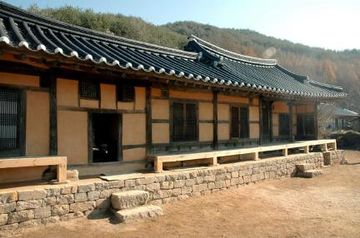안동 칩와당 고택
| 안동 칩와당 고택 Chibwadang House, Andong |
|
 안동 칩와당 고택, 국가문화유산포털, 문화재청. |
|
| 대표명칭 | 안동 칩와당 고택 |
|---|---|
| 영문명칭 | Chibwadang House, Andong |
| 한자 | 安東 蟄窩堂 古宅 |
| 주소 | 경상북도 안동시 도산면 온혜리 310 |
| 지정(등록) 종목 | 문화재자료 제436호 |
| 지정(등록)일 | 2003.04.14 |
| 분류 | 유적건조물/주거생활/주거건축/가옥 |
| 시대 | 조선 |
| 수량/면적 | 1동 |
| 웹사이트 | 안동 칩와당 고택, 국가문화유산포털, 문화재청. |
|
|
|
해설문
국문
2018
이 집은 칩와당(蟄窩堂) 이장형(李長亨, 1597~1671)의 고택이다. 건물의 정확한 건립연대는 알 수 없으나 대체로 약 200년 전에 건립된 것으로 추정되고 있으며, 약 100년 전에 중수가 있었다고 한다.
이 집은 정면 5칸, 측면 2칸의 ‘ㄷ’자형 안채와 정면 6칸, 측면 1칸의 ‘一’자형 문간채로 구성되어 있다. 20세기 초 중수 시에 일부 변경이 되었다고는 하나 전체적인 평면구성과 구조양식, 수납공간과 편의를 도모하기 위한 곳곳의 쪽마루, 그리고 환기창 등은 19세기 주택의 모습을 잘 나타내고 있다.
칩와당은 이징(李澄)의 둘째아들 건(騫)의 증손으로 만권의 서책을 소장하였다고 하며 문장과 글씨에 능하여 『동간세고(東澗世稿)』를 남겼다.
- 이장형이 살았던 시기와 칩와당 고택이 건립된 시기가 서로 맞지 않음.
2020
칩와당 고택은 조선 시대 때 칩와당 이장형(蟄窩堂 李長亨, 1597~1671)이 살던 집이다.
이장형은 이황(李滉, 1502~1570)의 형인 이징(李澄)의 4대손이다. 그는 만권의 서책을 소장하였다고 하며 문장과 글씨에 능하였다. 병자호란 이후 관직에 나가지 않고 고향에만 있었기 때문에 호를 ‘움집에 숨다’는 뜻의 ‘칩와당’이라고 하였다.
건물을 언제 지었는지 정확히 알 수 없으나, 20세기 초에 손보고 고쳤다. 안채와 문간채로 구성되어 있으며, 수납공간을 확보하기 위해 벽장을 설치하였다. 생활을 편리하게 하는 데 필요한 쪽마루와 환기창 등을 여러 곳에 둔 것이 독특하다.
영문
Chibwadang House, Andong
2018
This traditional Korean house was used as the residence of Yi Jang-hyeong (1597-1671, pen name: Chibwadang). He was a great writer and calligrapher and is said to have collected over ten thousand books.
It is unknown exactly when the house was first constructed, but it was reconstructed around the turn of the 20th century. This house consists of a main quarters and a gate quarters. Though its original appearance was partly changed during the reconstruction, its overall layout and structure, as well as features such as storage spaces, narrow wooden verandas, and ventilation windows, demonstrate the typical characteristics of private houses of the 19th century.
2020
This house was built by Yi Jang-hyeong (1597-1671, pen name: Chibwadang).
Yi Jang-hyeong was the great-great-grandson of the elder brother of the eminent Korean philosopher and Confucian scholar Yi Hwang (1502-1571). He was taught by Yi Hong-jung, a leader of a local civilian army during the Japanese invasions of 1592. After the king surrendered to Qing China during the Manchu invasion of 1637, he refused to serve a government post and retired to his hometown. He was said to have possessed a great number of books and was talented in writing and calligraphy. His written works were later published as a literary collection.
It is not clear when this house was first built, but it was renovated in the early 20th century. The house consists of a gate quarters and women’s quarters. The house features an added storage room, narrow wooden-verandas, and small windows that aid in ventilation. The name Chibwadang means “Hall of Hiding in a Pit-house,” referring to Yi Jang-hyeong’s aforementioned retirement.
영문 해설 내용
이 집은 조선시대의 인물인 칩와당 이장형(蟄窩堂 李長亨, 1597~1671)의 가옥이다.
이장형은 이황(李滉, 1502~1570)의 형인 이징(李澄)의 4대손이다. 그는 만권의 서책을 소장하였다고 하며 문장과 글씨에 능하였다. 병자호란 이후 관직에 나가지 않고 고향에 칩거하였기 때문에 호를 ‘움집에 숨다’는 뜻의 ‘칩와당’이라고 하였다.
건물의 정확한 건립연대는 알 수 없고, 20세기 초에 중수하였다. 안채와 문간채로 구성되어 있으며, 수납공간을 확보하기 위해 벽장을 설치하고 편의를 도모하기 위해 곳곳에 쪽마루와 환기창 등을 둔 것이 독특하다.
참고자료
- 경상북도 문화재자료 제436호 안동칩와당고택 (安東蟄窩堂古宅), 문화재청 국가문화유산포털. http://www.heritage.go.kr/heri/cul/culSelectDetail.do?pageNo=5_1_1_0&ccbaCpno=3413704360000
- 안동 칩와당 고택, 한국향토문화전자대전. http://www.grandculture.net/ko/Contents/Index